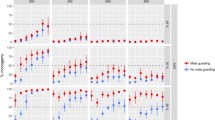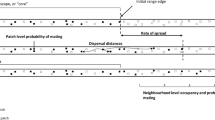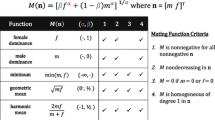Abstract
Many demographic and other factors are sex-specific. To assess their impacts on population dynamics, we need sex-structured models. Such models have been shown to produce results different from those predicted by asexual models, yet need to explicitly consider mating dynamics. Modeling mating is challenging and no generally accepted formulation exists. Mating is often impaired at low densities due to difficulties of individuals in locating mates, a phenomenon termed a mate-finding Allee effect. Widely applied models of this Allee effect assume either that only male density determines the rate at which females mate or that male and female densities are equal. Contrarily, when detailed models of mating dynamics are sometimes developed, the female mating rate is rarely reported, making quantification of the mate-finding Allee effect difficult. Here, we develop an individual-based model of mating dynamics that accounts for spatial search of one sex for another, and quantify the rate at which females mate, depending on male and female densities and under a number of reasonable mating scenarios. We find that this rate increases with male and female densities (hence observing a mate-finding Allee effect), in a decelerating or sigmoid way, that mating can be most efficient at either low or high female densities, and that the mate search rate may undergo density-dependent selection. We also show that mate search trajectories evolve to be as straight as possible when targets are sedentary, yet that when targets move the search can be less straight without seriously affecting the female mating rate. Some recommendations for modeling two-sex population dynamics are also provided.











Similar content being viewed by others

References
Ashih AC, Wilson WG (2001) Two-sex population dynamics in space: effects of gestation time on persistence. Theor Popul Biol 60:93–106
Bartumeus F, da Luz MGE, Viswanathan GM, Catalan J (2005) Animal search strategies: a quantitative random-walk analysis. Ecology 86:3078–3087
Bartumeus F, Catalan J, Viswanathan GM, Raposod EP, da Luz MGE (2008) The influence of turning angles on the success of non-oriented animal searches. J Theor Biol 252:43–55. https://doi.org/10.1016/j.jtbi.2008.01.009
Berec L, Maxin D (2013) Fatal or harmless: extreme bistability induced by sterilizing, sexually transmitted pathogens. Bull Math Biol 75:258–273. https://doi.org/10.1007/s11538-012-9802-5
Berec L, Maxin D (2014) Why have parasites promoting mating success been observed so rarely? J Theor Biol 342:47–61. https://doi.org/10.1016/j.jtbi.2013.10.012
Berec L, Bernhauerová V, Boldin B (2017a) Evolution of mate-finding Allee effect in prey. In revision
Berec L, Janoušková E, Theuer M (2017b) Sexually transmitted infections and mate-finding Allee effects. Theor Popul Biol 114:59–69. https://doi.org/10.1016/j.tpb.2016.12.004
Berec L, Kramer AM, Bernhauerová V, Drake JM (2018) Density-dependent selection on mate search and evolution of Allee effects. J Anim Ecol 87:24–35. in press. https://doi.org/10.1111/1365-2656.12662
Bessa-Gomes C, Legendre S, Clobert J (2010) Discrete two-sex models of population dynamics: on modelling the mating function. Acta Oecol 36:439–445. https://doi.org/10.1016/j.actao.2010.02.010
Blackwood JC, Berec L, Yamanaka T, Epanchin-Niell RS, Hastings A, Liebhold AM (2012) Bioeconomic synergy between tactics for insect eradication in the presence of Allee effects. Proc R Soc B 279:2807–2815. https://doi.org/10.1098/rspb.2012.0255
Boukal DS, Berec L (2002) Single-species models of the Allee effect: extinction boundaries, sex ratios and mate encounters. J Theor Biol 218:375–394. https://doi.org/10.1006/yjtbi.3084
Boukal DS, Berec L (2009) Modelling mate-finding Allee effects and populations dynamics, with applications in pest control. Popul Ecol 51:445–458. https://doi.org/10.1007/s10144-009-0154-4
Boukal DS, Berec L, Křivan V (2008) Does sex-selective predation stabilize or destabilize predator-prey dynamics? PLoS ONE 3(7):e2697. https://doi.org/10.1371/journal.pone.0002687
Caswell H (2001) Matrix population models, 2nd edn. Sinauer Associates, Sunderland
Caswell H, Weeks DE (1986) Two-sex models: chaos, extinction, and other dynamic consequences of sex. Am Nat 128:707–735
Courchamp F, Berec L, Gascoigne J (2008) Allee effects in ecology and conservation. Oxford University Press, Oxford
Dennis B (1989) Allee effects: population growth, critical density, and the chance of extinction. Nat Resour Model 3:481–538
Fauvergue X (2013) A review of mate-finding Allee effects in insects: from individual behavior to population management. Entomol Exp Appl 146:79–92. https://doi.org/10.1111/eea.12021
Fromhage L, Jennions M, Kokko H (2016) The evolution of sex roles in mate searching. Evolution 70:617–624. https://doi.org/10.1111/evo.12874
Gascoigne JC, Berec L, Gregory S, Courchamp F (2009) Dangerously few liaisons: a review of mate-finding Allee effects. Popul Ecol 51:355–372
Gurarie E, Ovaskainen O (2013) Towards a general formalization of encounter rates in ecology. Theor Ecol 6:189–202. https://doi.org/10.1007/s12080-012-0170-4
Hadeler KP, Waldstätter R, Wörz-Busekros A (1988) Models for pair formation in bisexual populations. J Math Biol 26:635–649
Howard RS, Lively CM (2003) Opposites attract? Mate choice for parasite evasion and the evolutionary stability of sex. J Evol Biol 16:681–689
Hutchinson JMC, Waser PM (2007) Use, misuse and extensions of “ideal gas” models of animal encounter. Biol Rev 82:335–359. https://doi.org/10.1111/j.1469-185X.2007.00014.x
Iannelli M, Martcheva M, Milner FA (2005) Gender-structured population modeling. SIAM, Philadelphia
Jeschke JM, Kopp M, Tollrian R (2002) Predator functional responses: discriminating between handling and digesting prey. Ecol Monogr 72:95–112
Kareiva PM, Shigesada N (1983) Analyzing insect movement as a correlated random walk. Oecologia 56:234–238. https://doi.org/10.1007/BF00379695
Klipp E, Herwig R, Kowald A, Wierling C, Lehrach H (2005) Systems biology in practice. Wiley-VCH, Berlin
Kot M (2001) Elements of mathematical ecology. Cambridge University Press, Cambridge
Kramer AM, Dennis B, Liebhold AM, Drake JM (2009) The evidence for Allee effects. Popul Ecol 51:341–354
Křivan V (2013) Behavioral refuges and predator-prey coexistence. J Theor Biol 339:112–121. https://doi.org/10.1016/j.jtbi.2012.12.016
Levitan DR (2000) Sperm velocity and longevity trade off each other and influence fertilization in the sea urchin Lytechinus variegatus. Proc R Soc B 267:531–534
Lindström J, Kokko H (1998) Evolutionarily singular strategies and the adaptive growth and branching of the evolutionary tree. Proc R Soc Lond B 265:483–488
McCartney J, Kokko H, Heller KG, Gwynne DT (2012) The evolution of sex differences in mate searching when females benefit: new theory and a comparative test. Proc R Soc B 279:1225–1232. https://doi.org/10.1098/rspb.2011.1505
Miller TEX, Inouye BD (2011) Confronting two-sex demographic models with data. Ecology 92:2141–2151
Møller AP (2003) Sexual selection and extinction: why sex matters and why asexual models are insufficient. Ann Zool Fenn 40:221–230
Molnár PK, Derocher AE, Lewis MA, Taylor MK (2008) Modelling the mating system of polar bears: a mechanistic approach to the Allee effect. Proc R Soc Lond B 275:217–226. https://doi.org/10.1098/rspb.2007.1307
Pound GE, Cox SJ, Doncaster CP (2004) The accumulation of deleterious mutations within the frozen niche variation hypothesis. J Evol Biol 17:651–662. https://doi.org/10.1111/j.1420-9101.2003.00690.x
Rankin DJ, Kokko H (2007) Do males matter? The role of males in population dynamics. Oikos 116:335–348. https://doi.org/10.1111/j.2006.0030-1299.15451.x
Rankin DJ, Dieckmann U, Kokko H (2011) Sexual conflict and the tragedy of the commons. Am Nat 177:780–791. https://doi.org/10.1086/659947
Real LA (1977) The kinetics of functional response. Am Nat 111:289–300
Robinet C, Liebhold A, Gray D (2007) Variation in developmental time affects mating success and Allee effects. Oikos 116:1227–1237. https://doi.org/10.1111/j.2007.0030-1299.15891.x
Shaw AK, Kokko H (2014) Mate finding, Allee effects and selection for sex-biased dispersal. J Anim Ecol 83:1256–1267. https://doi.org/10.1111/1365-2656.12232
Shaw AK, Kokko H, Neubert MG (2018) Sex differences and Allee effects shape the dynamics of sex-structured invasions. J Anim Ecol Ecol 87:26–46 In review
Snyder K, Kohler B, Gordillo LF (2017) Mass action in two-sex population models: encounters, mating encounters and the associated numerical correction. Lett Biomath 4:101–111. https://doi.org/10.1080/23737867.2017.1302827
Terry AJ (2015) Predator–prey models with component Allee effect for predator reproduction. J Math Biol 71:1325–1352. https://doi.org/10.1007/s00285-015-0856-5
Veit RR, Lewis MA (1996) Dispersal, population growth, and the Allee effect: dynamics of the house finch invasion of eastern North America. Am Nat 148:255–274
Viswanathan GM, Buldyrev SV, Havlin S, da Luz MGE, Raposo EP, Stanley HE (1999) Optimizing the success of random searches. Nature 401:911–914. https://doi.org/10.1038/44831
Wells H, Wells PH, Cook P (1990) The importance of overwintering aggregation for reproductive success of monarch butterflies (Danaus plexippus l.) J Theor Biol 147:115–131
Zera AJ, Denno RF (1997) Physiology and ecology of dispersal polymorphism in insects. Annu Rev Entomol 42:207–230
Funding
This study was funded by the Grant Agency of the Czech Republic (15-24456S) and institutional support RVO:60077344
Author information
Authors and Affiliations
Corresponding author
Ethics declarations
Conflict of interest
The author declares that he has no conflict of interest.
Electronic supplementary material
Below is the link to the electronic supplementary material.
Appendices
Appendix A: Continuous-time models of mating dynamics
Let each female encounter males at rate βm, for a positive constant β. This means that individual searchers scan a new area β each time unit. Moreover, the rate at which females mate equals βmf and thus follows the mass action law.
Scenario 1: Baseline
When males are not limited in their mating potential, the corresponding model of seasonal mating dynamics, assuming a large enough habitat area H2, is
Since male density m is constant, the density of unmated females declines exponentially as f(t) = f0 exp(−βmt) for an initial female density f0. Therefore, the proportion of females mated at the end of the mating season of length ϕ is
Scenario 2: Limited
Denoting by n m the male mating potential (i.e., the maximum number of matings any male may have during the mating season) and by m i , i = 1, …, n m , the densities of males that have already mated i times, then males of class i go to class i + 1 at rate βm i f, and become unavailable for mating after making n m transitions (i.e., after mating n m times). Therefore, under a limited male mating potential the baseline continuous-time model of mating dynamics (12) changes to
We note that n m = ∞ corresponds to unlimited polygyny (scenario 1). On the other hand, n m = 1 corresponds to male monogamy and the model (14) then reduces to
This model can be solved analytically. Indeed, Wells et al. (1990) showed that the female mating probability P depends on both male and female densities as
Scenario 3: Refractory
Denoting by m s and m r the densities of searching males and males currently in the refractory state, respectively, searching males enter the refractory class at the rate βm s f and leave it at the rate m r /T, where T is the (mean) length of refractory period. Therefore, modification of the baseline model (12) that accounts for the refractory period of males after each mating is
Scenario 4: Learning
Denote by m i and m e the densities of inexperienced and experienced males, respectively. Both types of males search for females at rate β. Moreover, inexperienced and experienced males mate with probability p0 and p1 upon encounter, respectively. After n t encounters with females, inexperienced males become experienced. With these assumptions, the baseline model (12) can be extended as
By analogy with predator-prey theory and cooperative enzyme dynamics (see the main text), this learning scenario is expected to produce a sigmoid form of the female mating probability. While a sigmoid form is hardly seen to non-existent when only the male density m varies (Fig. 12a), it is clearly seen when both male and female densities change and are kept at a constant ratio (Fig. 12b).
The mate-finding Allee effect for the learning scenario model (18) and for parameters β = 3, p0 = 0, and p1 = 1; the length of mating period ϕ = 4. Initial female density f = 0.08 in panel (a)
Scenario 5: Heterogeneity
The searchers may be heterogeneous in various ways. We return here to the baseline scenario and assume that males are not limited in their mating potential. Hence, each female’s mating probability at time t is P(t; m) = 1 − exp(−βmt). However, we let the parameter β differ among individual searchers, due to varying mate search rate. When females are the searching sex then the female mating probability becomes
where f(β) is a probability density function on β. On the other hand, when males are the searching sex then the female mating probability is
where μ β is the mean value of β.
Assuming a Gamma-distributed search area β per unit time,
and we get
and (Dennis 1989)
Here, τ is a shape parameter and 𝜃 is a rate parameter of the Gamma distribution which are related to mean μ β and variance var β as τ = (μ β )2/var β and 𝜃 = μ β /var β. For τ = 1, the Gamma distribution becomes an exponential distribution and P F (t; m) = m/(𝜃 + m), one of the forms most commonly used to describe the female mating rate in population models accounting for a mate-finding Allee effect (Dennis 1989; Boukal and Berec 2002; Terry 2015). On the other hand, letting τ →∞ and 𝜃 →∞ such that τ/𝜃 → β the baseline model P(t; m) = 1 − exp(−βmt) is recovered (Dennis 1989).
Summary of Scenarios 1–5
Figure 13 summarizes how density of mated females increases in time or with male and female densities for the five examined mating scenarios. The monogamy scenario (i.e., the limited scenario with n m = 1) is the worst scenario when the mating season is relatively long as the other scenarios allow males to mate multiply and hence increase the chance of females to meet at least one male. On the other hand, the learning scenario is the worst scenario if the mating season is relatively short as it catches up with male polygyny only when a majority of males are experienced. As we know from above, small refractory period and large male mating potential behave similarly to the baseline scenario with unlimited male polygyny. We also know from our individual-based simulations that heterogeneity in the mate search rate when females are the searching sex produces consistently lower female mating probabilities relative to the baseline scenario, while the results under heterogeneity in the mate search rate when males are the searching sex coincide with those for the baseline scenario.
Dynamics of analytical models of mating dynamics corresponding to Scenarios 1–5. The heterogeneity scenario here considers mate search rate heterogeneity in females; mate search rate heterogeneity in males would give results identical to the baseline scenario. The female mating probability is plotted as a function of a time, with m0 = f0 = 0.2, and b male and female density, with ϕ = 4, for parameters β = 3, n m = 2, T = 2, p0 = 0, p1 = 1, n t = 2, and var β = 5
Appendix B: Derivation of a simple continuous-time two-sex model
Here, we exemplify a sex-structured population model in which the processes of mating, reproduction, and mortality occur simultaneously. We assume that when a male and a female encounter one another they mate. Upon mating, the female enters a gestation period of length t F after which it gives birth to b offspring following a 1:1 sex ratio and then resumes mate search. Mated males are assumed to enter a refractory period of length T. Moreover, males and females die at rates m M and m F , respectively. We distinguish four state variables: searching males M s and females F s , and resting males M r and females F r . A continuous-time two-sex model may then be as follows:
Rights and permissions
About this article
Cite this article
Berec, L. Mate search and mate-finding Allee effect: on modeling mating in sex-structured population models. Theor Ecol 11, 225–244 (2018). https://doi.org/10.1007/s12080-017-0361-0
Received:
Accepted:
Published:
Issue Date:
DOI: https://doi.org/10.1007/s12080-017-0361-0





